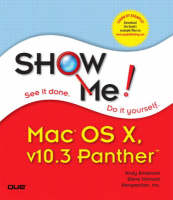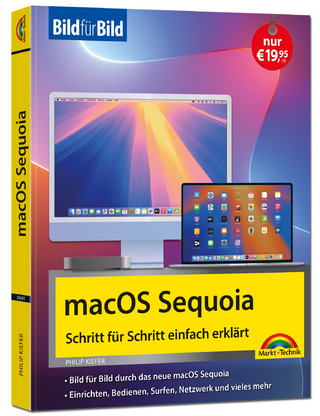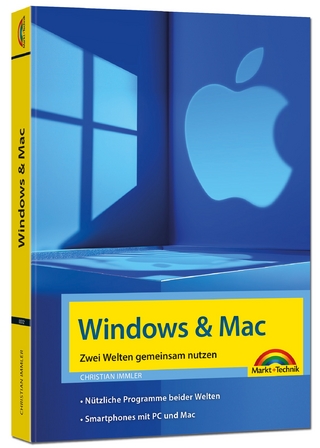
Show Me Mac OS X Panther
Que Corporation,U.S. (Verlag)
978-0-7897-3066-4 (ISBN)
- Titel ist leider vergriffen;
keine Neuauflage - Artikel merken
Show Me Mac OS X offers readers a fast, visual way to learn and solve their Mac OS problems. All the most important tasks are covered, using clear, step-by-step instructions with accompanying visuals. The book covers system-level functions, as well as the many accessories and free applications that come with Mac OS X, such as the popular iTunes, iMovie, and iCal programs. This easy-to-use book includes Show Me Live! Software that shows you how to perform everyday tasks and helps you gain real-world experience. Other features include a Troubleshooting Guide to help you solve common problems.
Andy Anderson is a graphics designer and illustrator who has worked with Flash since it was released. A university professor, Andy is a sought-after lecturer in the U.S., Canada, and Europe. The remainder of his time is split between writing graphics and fiction books, and developing graphics, animations, and resource materials for various corporations and seminar companies. His clients include designers and trainers from the U.S. Government, Boeing, Disneyland, and other Fortune 500 companies. He is also the author of 1001 Photoshop Tips and Tricks, Photoshop 7 Studio Workshop, HTML & Web Design, Show Me Adobe Photoshop CS, and Show Me Flash MX 2004. Steve Johnson has written more than thirty-five books on a variety of computer software, including Microsoft Office 2003 and XP, Microsoft Windows XP, Macromedia Flash MX 2004, Macromedia Director MX 2004, Macromedia Fireworks, and Web publishing. In 1991, after working for Apple Computer and Microsoft, Steve founded Perspection, Inc., which writes and produces software training. When he is not staying up late writing, he enjoys playing golf, gardening, and spending time with his wife, Holly, and three children, JP, Brett, and Hannah. When time permits, he likes to travel to such places as New Hampshire in October, and Hawaii. Steve and his family live in Pleasanton, California, but can also be found visiting family all over the western United States.
Introduction.
1. Getting Started with Mac OS X Panther.
Starting Mac OS X. Exploring the Finder and Desktop. Using the Mouse. Working with Menus, Toolbars, and Panes. Using Menus for Quick Results. Choosing Dialog Options. Working with Icons. Viewing Windows. Managing Windows. Exposing Windows. Using the Sidebar. Using Toolbars. Displaying and Using the Dock. Getting Help While You Work. Switching Users. Sleeping, Restarting, and Shutting Down.
2. Managing Files and Folders.
Opening and Viewing Disks. Viewing and Opening Documents. Changing the Window View. Arranging Files and Folders in Icon View. Working with Files and Folders in List View. Working with Files and Folders in Column View. Going to Common or Recent Places. Organizing Files and Folders by Color. Searching for Files Using the Search Bar. Searching for Files Using the Find Window. Creating and Renaming Files and Folders. Copying and Moving Files and Folders. Using Spring-Loaded Folders. Sharing Files or Folders with Others. Deleting and Restoring Files and Folders. Getting and Setting File Information. Creating a CD or DVD Using the Finder. Mounting and Ejecting Disks.
3. Customizing the Finder.
Understanding Finder Preferences. Showing Icons on the Desktop. Customizing the Way Windows Open. Showing or Hiding File Extensions. Customizing Finder Window Views. Customizing the Toolbar. Customizing the Sidebar. Customizing the Dock. Creating Aliases. Customizing Expos8E. Using Simple Finder. Tinkering Around. Customizing Other Ways.
4. Setting System Preferences.
Understanding System Preferences. Viewing System Preferences. Locking and Unlocking Preference Settings. Changing Appearance Options. Setting Up the Desktop. Setting Up Screen Savers. Setting the Date and Time. Changing International Options. Setting Universal Access Options. Saving Energy. Selecting a Startup Disk. Changing the Way a CD or DVD Starts. Setting QuickTime Options. Controlling Sound. Recognizing Your Speech. Letting Mac Do the Talking. Setting Ink Preferences.
5. Using Mac OS X Applications.
Using Mac OS X Applications. Launching Applications. Opening Applications and Files. Quitting Applications. Switching Between Applications. Creating an Address Book. Editing an Address Book. Managing an Address Book. Adding an Image to an Address Book. Playing Chess. Performing Calculations and Conversions. Capturing Images with a Digital Camera. Capturing Screen Shots with Grab. Previewing Images and PDF's. Playing DVD Movies. Playing QuickTime Movies. Creating Sticky Notes. Managing Fonts with Font Book. Activating, Deactivating, and Customizing Fonts. Understanding AppleScript Basics. Using Ready-Made AppleScripts. Writing and Recording AppleScripts.
6. Working with Documents.
Creating and Opening a Document. Editing Text. Recognizing Handwriting Ink. Making Corrections. Changing Text Wrap. Checking Spelling. Finding and Replacing Text. Formatting Text. Displaying Rulers. Setting Paragraph Tabs. Setting Paragraph Indents. Changing Character Spacing. Changing Line Spacing. Applying and Creating a Style. Inserting Special Characters. Adding Pictures, Movies, or Files to a Document. Saving and Closing a Document. Setting TextEdit Preferences.
7. Printing and Faxing.
Understanding Printers. Understanding Printer Drivers. Using the Printer Setup Utility. Setting Print and Fax Settings. Setting Up Page Options. Setting Basic Print Options. Previewing Documents. Saving Documents as PDF Documents. Using Desktop Printers. Managing Print Queues. Scheduling Print Jobs. Creating a Cover Page. Sending Fax Documents. Receiving Faxes Automatically on Your Computer. Addressing Faxes from the Address Book.
8. Exploring the Internet.
Connecting to the Internet. Setting Up a Modem Connection. Setting Up a Built-In Ethernet Connection. Setting Up an AirPort Connection. Setting Up Multiple Connections. Using Internet Connect. Understanding Web Sites and Browsers. Starting Safari. Viewing the Safari Window. Customizing the Safari Window. Browsing the Web. Browsing the Web Using Tabs. Navigating Basics. Changing the Home Page. Viewing a History List. Bookmarking a Web Page. Working with Bookmarks. Filling Out Forms on the Web. Searching the Web. Printing a Web Page. Saving a Web Page. Saving Pictures or Text from a Web Page. Downloading Files from the Web. Setting Safari Preferences. Setting Security Preferences. Blocking Pop-Up Windows. Selecting a Default Browser.
9. Using Sherlock for Internet Searches.
Understanding Collections and Channels. Using the Internet Channel. Using the Pictures Channel. Using Third-Party Channels. Using the Stocks Channel. Using the Movies Channel. Using the Phone Book Channel. Using the eBay Channel. Using the Flights Channel. Using the AppleCare Channel. Using the Dictionary Channel. Using the Translation Channel. Customizing Sherlock.
10. Exchanging Messages Using Mail.
Starting Mail. Setting Up an Account. Managing Accounts. Viewing the Mail Window. Composing and Sending an E-Mail. Addressing an E-Mail. Formatting Message Text. Adding an E-Mail Signature. Receiving and Reading E-Mail. Responding to E-Mail. Sending and Retrieving a File. Managing E-Mail. Deleting E-Mail. Saving E-Mail. Searching E-Mail for Text. Diverting Incoming E-Mail to Mailboxes. Blocking and Bouncing E-Mail.
11. Exploring .Mac Services.
Joining the .Mac Community. Accessing Your .Mac Account. Setting Up .Mac Mail. Managing .Mac Mail. Sending an iCards Message. Creating a .Mac Address Book. Syncing a .Mac Address Book. Working with .Mac Bookmarks. Creating Web Pages with HomePage. Editing Web Pages with HomePage. Backing Up Your Files Using .Mac. Managing Files with iDisk. Protecting Files with Virex. Getting Online Support.
12. Conducting Live Chats and Video Conferences.
Creating an Instant Message Account. Starting iChat AV. Viewing iChat AV. Changing My Status. Using the iChat Status Menu. Adding a Buddy. Creating and Managing Buddy Groups. Sending and Receiving Instant Messages. Blocking a Buddy. Sending a File During an Instant Message. Having a Audio and Video Chat. Chatting on a Local Network. Changing the Appearance of a Chat. Getting Notification Alerts.
13. Tracking and Synchronizing Information.
Viewing the iCal Window. Creating a To Do List. Adding and Editing Calendar Events. Publishing and Subscribing to a Calendar. Setting iCal Preferences. Viewing the iSync Window. Adding Portable Devices to iSync. Setting Up .Mac Synchronization. Setting Device Synchronization Options. Keeping Track of Passwords with Keychain. Adding Keychains. Managing Keychains.
14. Working with Music and DVDs.
Viewing the iTunes Window. Setting Up iTunes to Automatically Play CDs. Creating Playlists. Adding Songs to a Playlist. Listening to Internet Radio. Burning CDs and Exporting to MP3 Players. Using the iTunes Music Store. Setting iTunes Preferences. Using iPod with iTunes. Viewing the iDVD Window. Creating a Project and Selecting a Theme. Adding and Modifying Titles. Adding Menus, Buttons, and Folders. Creating a Slideshow. Setting iDVD Preferences. Burning and Using a DVD. Erasing a CD or DVD.
15. Working with Photos and Movies.
Viewing the iPhoto Window. Importing Images. Organizing Images. Editing Photos. Creating a Photo Book. Sharing Photos with Others Using Print or E-Mail. Understanding iMovie Basics. Viewing the iMovie Window. Creating an iMovie Project. Recording Video. Recording Audio. Adding Media to an iMovie. Moving and Trimming Clips. Adding Titles. Adding Transitions. Adding Effects. Exporting an iMovie to Camera. Exporting iMovies to the Web and E-Mail. Putting iMovies on CD or DVD.
16. Setting Up Accounts and Maintaining Security.
Understanding User Accounts. Activating the Login Window. Adding a User Account. Deleting a User Account. Setting Account Access Privileges. Setting File Access Permissions. Specifying Log In and Start Up Items. Setting Fast User Switching. Setting System Security Preferences. Restoring the Administrator Password. Managing Files with the Home Folder. Protecting the Home Folder with FileVault. Sharing Files with Other Users.
17. Managing Files Using a Network.
Using Network Sharing Services. Setting Up a Local Area Network. Setting Up an AirPort Wireless Network. Setting Up a Bluetooth Wireless Network. Moving Items with Bluetooth. Browsing the Network with the Finder. Setting Up File Sharing. Connecting to Another Computer for File Sharing. Connecting to a Network Over the Internet. Creating Privileges for Users and Groups. Connecting from a Windows Computer. Sharing an Internet Connection. Configuring an Internet Firewall. Exploring Additional Utility Applications. Setting Bluetooth Preferences.
18. Maintaining Your Computer.
Downloading and Installing Software. Automating Software Updates. Opening Compressed Files. Backing Up and Restoring Compressed Files and Folders. Using Application Services. Understanding Disk File Systems. Formatting and Copying a Disk. Recording or Duplicating a Data CD. Fixing Disk Problems. Optimizing a Disk. Monitoring System Activities. Viewing System Messages with the Console. Viewing System Information with System Profiler. Forcing a Restart.
19. Managing Hardware.
Installing Hardware Devices. Viewing Hardware Settings. Changing Mouse Settings. Changing Keyboard Settings. Changing Modem Options. Changing Phone Settings. Changing Monitor Display Settings. Measuring Display Colors with the Digital Color Meter. Selecting Colors with the Color Picker. Matching Colors to Devices with ColorSync. Configuring Audio MIDIDevices. Preventing Hardware Problems. Removing Hardware Devices.
20. Using Basic Unix Commands.
Understanding UNIX and Mac OS X. Viewing Man Pages for a Command. Listing Directory Contents. Moving Around Directories. Getting the Directory Location. Creating a New Directory. Using Wildcards in File Names and Directories. Viewing File Contents. Copying and Moving Files. Removing Files or Directories. Creating and Editing Files with Pico. Redirecting Output. Changing UNIX Passwords. Changing Permissions for a File or Directory.
Appendix A. Using the Classic Environment.
Installing Mac OS 9. Setting Classic Preferences. Using Classic Applications. Starting Your Computer with Mac OS 9.
Appendix B. Installing Mac OS X Panther.
Preparing to Install Mac OS X Panther. Determining the Current Mac OS Version. Installing Mac OS X 10.3. Configuring Mac OS X 10.3. Downloading Mac OS X Tools from Apple.
New Features.
Keyboard Shortcuts.
Troubleshooting.
Index.
| Erscheint lt. Verlag | 15.4.2004 |
|---|---|
| Sprache | englisch |
| Maße | 233 x 206 mm |
| Gewicht | 993 g |
| Themenwelt | Informatik ► Betriebssysteme / Server ► Macintosh / Mac OS X |
| ISBN-10 | 0-7897-3066-9 / 0789730669 |
| ISBN-13 | 978-0-7897-3066-4 / 9780789730664 |
| Zustand | Neuware |
| Informationen gemäß Produktsicherheitsverordnung (GPSR) | |
| Haben Sie eine Frage zum Produkt? |
aus dem Bereich


